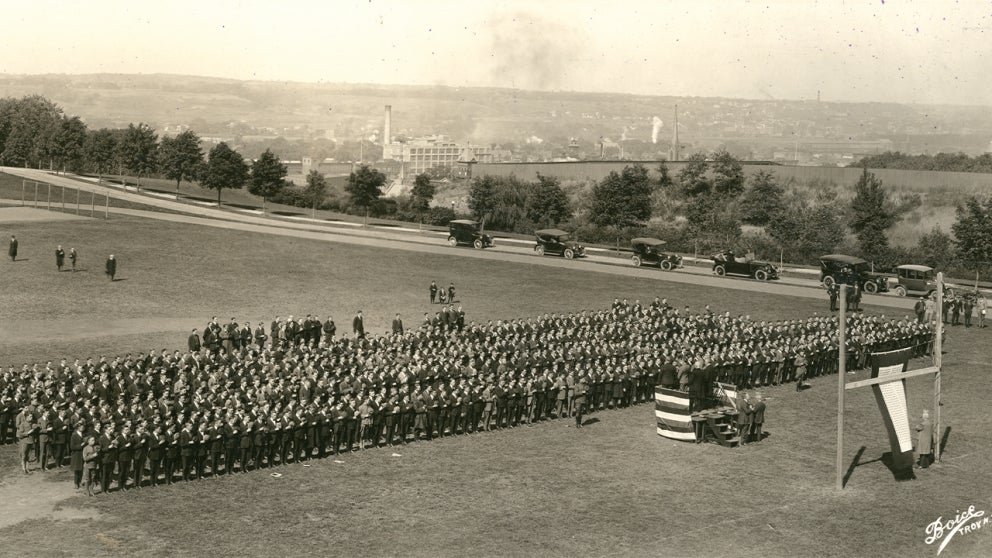
From the Archives
Before COVID-19, A Look at Past Pandemics

In 1918, the Spanish flu arrived at Rensselaer. Also known as the 1918 flu pandemic, the Spanish flu was an unusually deadly influenza pandemic caused by the H1N1 influenza A virus. Lasting from February 1918 to April 1920, it infected 500 million people — about a third of the world’s population — in four successive waves.
To aid in the war effort, in 1918, the U.S. War Department created the Student Army Training Corps (SATC) to encourage young men to receive a college education while training for the military. A unit was established at Rensselaer and in October 1918, 650 students in the Rensselaer SATC were about to move into temporary barracks set up in the ’87 Gym, Student Clubhouse, and new dormitories. However, the flu was rampant in the SATC and forced the students into the infirmary and other places on campus. By the end of October, six students had died.
Thirty-nine years later, in October 1957, nearly 20% of the 4,000 students at Rensselaer were suffering from the Asiatic flu, a pandemic of influenza A virus subtype H2N2 that originated in southern China and killed an estimated one to four million worldwide.
Many of the affected students were freshmen. The infirmary was filled to capacity and additional beds were set up to house the ill in the 15th Street Lounge, today known as the Playhouse. Large events were rescheduled or canceled to avoid a further outbreak.
The 1968 Hong Kong flu followed nearly a decade later. Caused by a virus known as influenza A subtype H3N2, the disease was highly contagious.
According to The Polytechnic, 35 students were confined at the infirmary the week prior to Dec. 18, 1968, and the dining room was set up for overflow. Worldwide, the Hong Kong flu killed an estimated one to four million people.
In recent years, the 2009 swine flu was caused by the same H1N1 influenza virus as the Spanish flu. It lasted approximately 19 months and a total of 64 cases were reported on campus. It was the first time Rensselaer instituted a symptom-tracker for the campus community.
Not surprisingly, Rensselaer researchers have sought to provide solutions to the challenges presented by pandemics. In 2010, computer scientist Mukkai Krishnamoorthy was lead author on a paper introducing a hybrid model for pandemics considering both global and local spread of infections. He also authored papers on the spread of the Asiatic and Spanish flus.
Today, that type of modeling continues, focusing on COVID-19. Faculty and students in all disciplines are also devising solutions to one of the greatest health challenges of today.
Pandemics have impacted colleges for centuries. In 1665, “social distancing” orders emptied campuses throughout England, as the bubonic plague raged. A 24-year-old student named Isaac Newton from Trinity College in Cambridge was among those forced to return indefinitely to his childhood home.
There, Newton’s creativity flourished. During his time away from school, he made major progress in his research on gravitation, light, and mathematics.
The year-plus he spent away was later referred to as his annus mirabilis, the “year of wonders.”
In an article in the journal Science, Bolek Szymanski, the Claire and Roland Schmitt Distinguished Professor of Computer Science, discusses the paths researchers may take in their work. Szymanski uses an analogy inspired by Newton’s thoughts on his own research: He describes a scientific career as a walk along the beach, moving from one interesting shell (in this case, a research topic) to another.
“Epidemics, like in the case of Newton, gave him and give us a little bit of time to think, what is really important? It’s a chance to think about how we can make our careers more meaningful,” he says. “During this difficult time, we throw aside what we do in order to try to understand if our skills could help. I’m very proud of RPI. So many people used their knowledge to be helpful in this new situation.”
Related:
-
Institute Archives and Special Collections Blog Post: “Flu Pandemic Retrospect”















